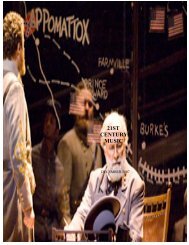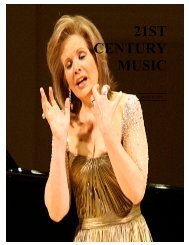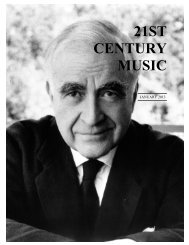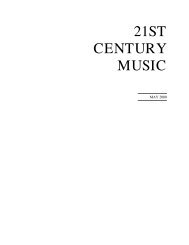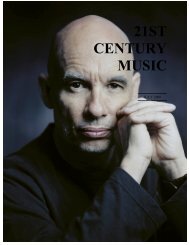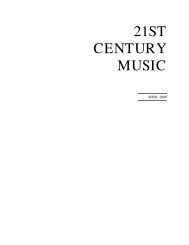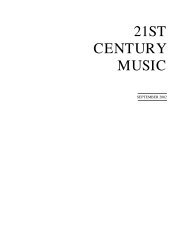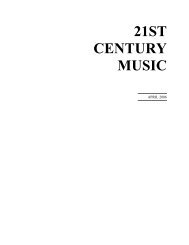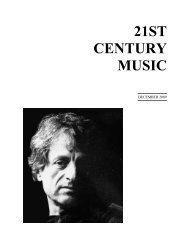You also want an ePaper? Increase the reach of your titles
YUMPU automatically turns print PDFs into web optimized ePapers that Google loves.
Lou Harrison is such a famous figure that it's easy to take him<br />
for granted, and, since only a handful of his pieces tend to be<br />
performed by orchestras, the three-work tribute June 15 was a<br />
welcome atonement for that relative neglect. His Symphony<br />
No. 3 (1937-1982) is the most outgoing of his four, and its<br />
spirit is like that of the Brahms Symphony No. 2. Yet Thomas<br />
failed to make a convincing case for it -- the first movement<br />
allegro moderato was taken too fast and the tempos throughout<br />
were metronomically regular. The orchestra seems to resist<br />
this piece; it certainly resisted Dennis Russell Davies when he<br />
premiered it here. Things improved with the Suite for Violin<br />
with American Gamelan (1972) which Harrison co-composed<br />
with Richard Dee. This is a contained and seductive piece<br />
which showcases the composer's gift for long-breathed<br />
melodies (the Chinese parts were probably by Dee). Young<br />
Korean violinist Chee-Yun gave an engaged yet poised<br />
performance, ably supported by the contributions of eight<br />
percussionists. The 1972 Concerto for Organ with Percussion<br />
Orchestra, which Thomas led several seasons ago with the<br />
Symphony, emerged the pick of the litter, with wide color<br />
contrasts, and whacking and thwacking galore (the drum<br />
boxes were painted Tiffany blue), and who's ever heard a<br />
spiky horror movie interlude and a celeste doing tone clusters<br />
in the same piece Harrison proved that music can be<br />
entertaining and deep, and not many composers can manage<br />
both.<br />
The June 20 program showed off Thomas's training orchestra,<br />
The New World Symphony. And though it didn't make much<br />
sense on paper, each piece made its points. The NWS was also<br />
acutely sensitive to matters of style. Earle Brown's 1975<br />
Cross Sections with Color Fields is an extraordinary piece<br />
which should be heard more often, and a workable<br />
compromise between open form, which he invented, and the<br />
closed form we're used to. Unfortunately the open form parts,<br />
which can be done in any order or juxtaposed, didn't arrive<br />
from his publisher -- only the 10 events of section H were<br />
included. Thomas solved this problem by adjusting attacks<br />
and dynamics throughout. This conveyed the score's essential<br />
mystery -- the sounds well up and disappear just as<br />
unexpectedly as they do in Takemitsu or Dutilleux, and there<br />
are fierce, primitive sections which sound as unconsciously<br />
bidden as the refined ones.<br />
Steve Mackey's 2000 Tuck and Roll for electric guitar and<br />
orchestra couldn't be more different. Brightly colored, crowdpleasing,<br />
with glitzy Gershwin string writing and patches<br />
which sound like music for a yet-to-be-made Tim Burton<br />
movie.<br />
The Ives Symphony No. 2 (1901) is as compact and<br />
contrapuntal as the Mackey was diffuse and self-conscious.<br />
Ives' textbook facility blends Dvorak, Mahler, and Wagnerstyle<br />
writing with American hymn tunes and popular songs,<br />
and there are moments where 5ths sound an archaic note in all<br />
this polyphony. But Ives makes it all sound perfectly natural,<br />
even logical. He was as isolated in America as Haydn was at<br />
Esterhazy. That forced him to be original, and it's still making<br />
our best composers original too. But what about Virgil<br />
Thomson, Henry Brant, Roy Harris, and Philip Glass Aren't<br />
they mavericks too Perhaps Thomas will include them in<br />
further installments of this festival. We'll just have to wait and<br />
see.<br />
Goat's Voices<br />
ROBERT WEISS<br />
Fresh Voices. Anne Doherty's Dan (Destiny), John Partridge's<br />
The Soldiers Who Tried to Kill Death, Mark Alburger's<br />
Sidewalks of New York: Henry Miller in Brooklyn (libretto by<br />
Mel Clay), Valarie Morris's Amsterdam and Paris with a Side<br />
of Eggs, and Mary Watkin's Queen Clara: Fields of Glory,<br />
Rivers of Blood (libretto by Lawrence Belville). June 17, Goat<br />
Hall, San Francisco, CA. Repeated June 18.<br />
Goat Hall Opera presented on June 17 Fresh Voices, a fivestar<br />
performance of excerpts from new works by San<br />
Francisco Bay Area composers and librettists, and an<br />
affirmation that new music is alive and well. Scenes from five<br />
new operas were presented, ranging in style from Valarie<br />
Morris's light comedy, Amsterdam and Paris with a Side of<br />
Eggs, to Lawrence Belville and Mary Watkin's Queen Clara<br />
[Barton]: Fields of Glory, Rivers of Blood, a dramatic oratoriolike<br />
array of exquisite solos with rich choral back-up. The<br />
opening excerpt from Anne Doherty's Dan (Destiny) was a<br />
politically oriented fantasy sprinkled with parodies of wellknown<br />
American patriotic songs. The cast of John Partridge's<br />
The Soldiers Who Wanted to Kill Death, consisted of three<br />
outstanding male voices (John Adams, Douglas Mandell, and<br />
Aurelio Viscarra) in solos and magnificent trios. In Mel Clay<br />
and Mark Alburger's The Sidewalks of New York: Henry<br />
Miller in Brooklyn, sex and creativity are presented in an<br />
intricate package -- sometimes with abandon. It appears that<br />
Goat Hall productions has earned its place as one of the Bay<br />
Area's most inventive and imaginative musical groups.<br />
25



